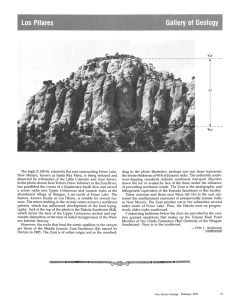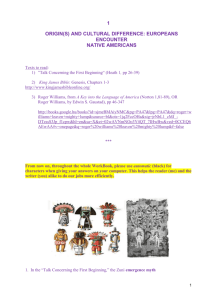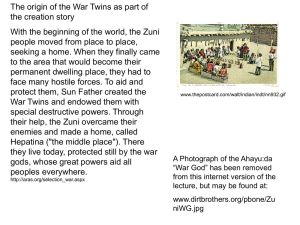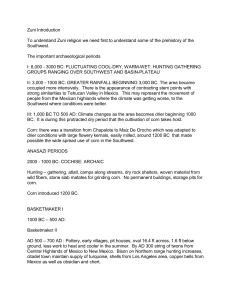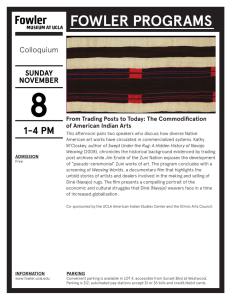Zuni Cultural Relationships to Piiion Juniper woodlaids -
advertisement
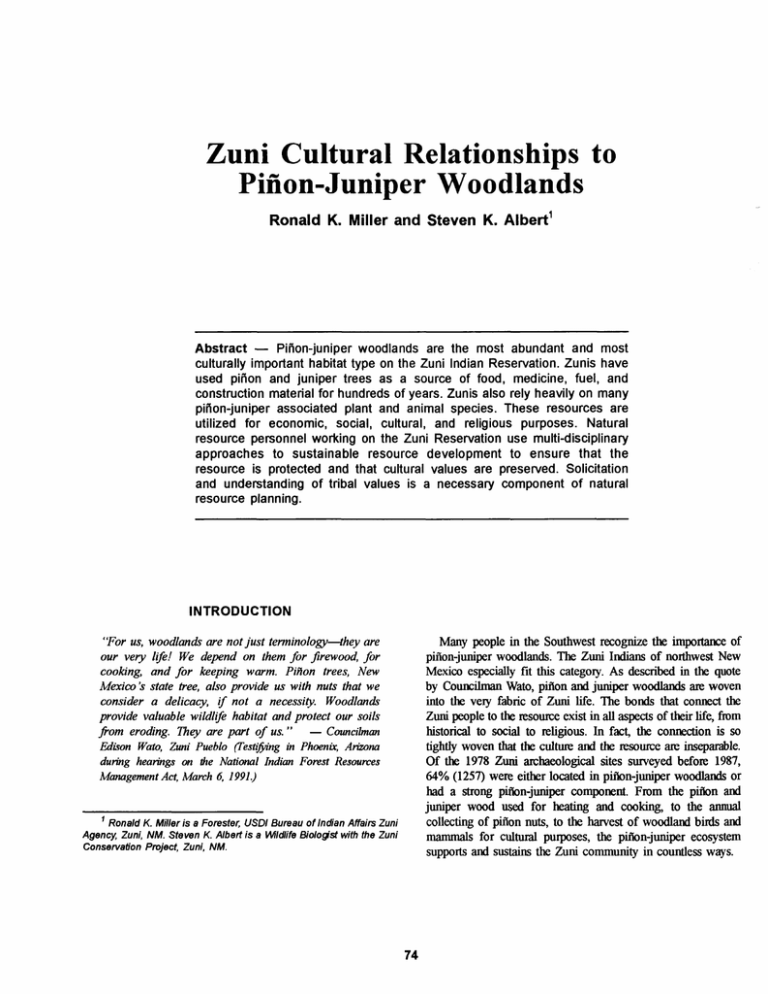
Zuni Cultural Relationships to PiiionJuniper woodlaids Ronald K. Miller and Steven K. ~ l b e r t ' - Abstract Piiion-juniper woodlands are the most abundant and most culturally important habitat type on the Zuni Indian Reservation. Zunis have used piiion and juniper trees as a source of food, medicine, fuel, and construction material for hundreds of years. Zunis also rely heavily on many pinon-juniper associated plant and animal species. These resources are utilized for economic, social, cultural, and religious purposes. Natural resource personnel working on the Zuni Reservation use multi-disciplinary approaches to sustainable resource development to ensure that the resource is protected and that cultural values are preserved. Solicitation and understanding of tribal values is a necessary component of natural resource planning. INTRODUCTION "For us, woodlanh are not just terminology-they are our very life! We depend on them for $rewood, for cooking, and for keeping warm. Piiron trees, New Mexico's state tree, also provide us with nuts that we consider a delicacy, if not a necessity. Woodlands provide valuable wildlife habitat and protect our soils j-om eroding. They are part of us." - Councilman Hkon Wato, Zuni Pueblo (Testiing in Phoenix, Aniona during hearings on the National Indian Forest Resources Mmgement Act, March 6, 1991.) ' Ronald K. Miller is a Forester, USDl Bureau of lndian Affairs Zuni Agency, Zuni, NM. Steven K. Albert is a Wldlife Biologst with the Zuni Conservation Project, Zuni, NM. Many people in the Southwest recognize the importance of piiion-juniper woodlands. The Zuni Indians of northwest New Mexico especially fit this category. As described in the quote by Councilman Wato, pifion and juniper woodlands are woven into the very fabric of Zuni life. The bonds that connect the Zuni people to the resource exist in all aspects of their life, fmm historical to social to religious. In fact, the connection is so tightly woven that the c u l m and the resource m inseparable. Of the 1978 Zuni archaeological sites surveyed before 1987, 64% (1257) were either located in piaon-juniper woodlands or had a strong piiron-juniper component. From the piiion and juniper wood used for heating and cooking, to the annual collecting of piiion nuts, to the harvest of woodland birds and mammals for cultural purposes, the piiron-juniper ecosystem supports and sustains the Zuni community in countless ways. Of the 419,026 acres that comprise the Zuni Indian Resewation, 46% of the land, or 194,618 acres, is covered with piiion-juniper woodlands. Woodlands on the Resewation range in elevation from 1877 meters (6100 feet) to 2369 meten (7700 feet). ZUNl WOODLAND TREE SPECIES The primary woodland tree species that grow on the Zuni Reservation are piEIon pine (Pinus edulis) and three types of juniper-Rocky Mountain juniper (Juniperus scopulorum), one-seed juniper (Juniperus monosperma), and alligator juniper (Juniperus deppeana). The Zuni names for these four species are: - He'sho Piiion Homa:k 'yahaya - Rocky Mountain Juniper Ayhik'o - One-seed Juniper Asuk 'o - Alligator Juniper While the Spanish named the piiion for the nut it produces, the Zunis named the tree after its valuable sap. "He'sho" literally means "pitch". Pifbn pitch has been used by Zunis for centuries as an antiseptic (Stevenson 1915), as a pottely glaz, and was even applied to stones used in balung bread for religious occasions (Cushmg 1920). Pitch is also burned to purify the air during certain religious ceremonies. Probably the most wide-spread use of the piiion both on and off the Reservation, however, is for the nutritious seed: the piEIon nut. NUTS Archaeological remains show evidence that piiion nuts were eaten in Zuni as long ago as A.D. 1000~(Brandt and Ruppe 1990a). Piiion nuts were also discovered preserved in cooking jars in burials at the ancient Zuni village of Hawikuh when that site was excavated by F.W. Hodge between 1917-1923 (Mdls 1976). However; some researchers believe early human use of piflon nuts in Zuni and other sites was not extensive due to piflon nut ecology (Floyd and Kohler 1989). Piflon pines exhibit large reproductive events, followed by many subsequent years of little or no seed. This reproductive strategy may temporarily overwhelm seed-eating predators, and ensure that some seeds survive to produce new trees. This aspect of piflon ecology probably made the piflon nut an unreliable food source. Floyd and Kohler also cite evidence that pre-historic use of pMon nuts as a food source was inversely related to both the degree of agricultural intensification, and use of the piflon tree as fuel wood. Frank Hamilton Cushing, the noted archaeologist and ethnologist who lived for many years in Zuni during the latter part of the 19th century, described the use of ground piiion nut as shortening, flavoring, and as a thickening agent in cooked foods (Cushmg 1920). Today, an estimated 80% of the Zuni people still collect piiIons (K. Manolescu, unpubl. data). Although many Zuni people collect piilon nuts strictly for personal consumption, others derive a substantial economic benefit from hawesting and selling the nuts. Marry who choose not to sell the nuts do so with the belief that piiion nuts are a @ fi.om the Creator and, as such, are not to be sold (Owen Bobely pen. commun). A bumper crop of piiion nuts occurred in Zuni and other parts of the Southwest in 1992. For weeks, people searched the woodlands for the abundant seeds. Large crops are sometimes viewed as a mixed blessing because of a particular belief many Zunis have about the relationship between themselves and the piiion nuts. It is said that the occurrence of many Zuni deaths precedes an abundant crop of piilon nuts (Lowsayate 1985). Piiions are not the only woodland txe that provides a food crop. Junipers provide food for Zunis as well. Favorite Zuni dishes such as blood sausage and com-bread are sometimes flavored with juniper berries. Historically, alligator juniper berries were also eaten, either raw or steamed (H. Johnson, pen. commun). Stevenson (1915) also reported that a tea of juniper twigs were drunk by pregnant women immediately prior to childbirth in order to promote muscular contractions. ZUNl USES OF PINON AND JUNIPER WOOD In addition to the nuts and berries provided by woodland trees, inhabitants of the Zuni area have relied on the wood of the piiion and juniper for centuries for heating, coolung, and builpurposes. There is evidence that as the local pre-historic population grew, the Zuni River Valley was subject to deforestation (Brandt and Ruppe 1990b). Current use of pifion and juniper wood on the Zuni Reservation is extensive. In 1992, an estimated 9,200 cords of fuelwood were burned for cookmg and heating purposes. The fact that the demand for fbelwood is so great on the Reservation could be a cause for concern if this resource could not sustain itself. At least for the present the supply of fhelwood on the Reservation far exceeds the demand of the residents. This is particularly true because the traditional method of gathering fuelwood has been to collect only dead material. The foresby permit system, as outlined in the Zuni Forest Products Policy, encourages this traditional practice to continue. Tribal members do not need a permit to collect dead wood. However, a pennit is required any time live trees are cut. As the tribal population increases, the luxury of having an abundant wood resource could change. Recently, the Zuni Tribal Council passed a resolution banning the harvesting of alligator juniper. This species has the most restricted range of any of the woodland tree species on the Zuni Reservation and has recently come under increasing harvesting pressure. Although the wood is a favorite among woodcutters, the Tribal Council acted decisively when the future sustainability of this important tree was judged uncertain. The current ban protects all of the remaining alligator juniper, Reservation-wide. Junipers are still the most desired wood species for use in the outdoor rock and mud ovens. Zuni bread is cooked in the ovens year-round, especially during ceremonial events, by heat generated from juniper wood. Huge piles of juniper can be seen stacked beside the ovens all around the pueblo. Boughs from Rocky Mountain juniper are also used to clean out the ashes and coals after the ovens have reached the right temperature. Before the advent of electricity, Zunis commonly made torches from juniper bark (Cushing 1920). P&n wood, on the other hand, is sought after to heat homes. Many of the traditional red rock houses still exist in the Pueblo, and most of these houses are heated solely with wood. Several woodland projects and a tribal wood yard have been established in Zuni in recent years to provide for the local fuelwood need while still protecting the woodland resource (Mdler 1993). The woodland projects are set up using uneven-age silvicultural methods designed to retain the healthiest trees and the best piiion nut producers. Historically, the needles of the pi&n tree were consumed as a remedy for the symptoms of syphillis, while the buds and shoots of the tree were eaten by members of the Great Fir Society in order to produce female children (Stevenson 1915). Other important uses of piiion and juniper wood relate to the ranching tmde. Junipers are prized fence-post material because their natural tannins protect the wood from insect attack and most types of decay, even long after the tree is dead. A permit must be obtained before cutting fenceposts, since the junipers are alive when harvested. In 1992, permits for 2,975 fenceposts were issued. Sheep corrals also utilize the junipers. In this case, the boughs of the juniper provide the construction material. WOODLAND ASSOCIATED WILDLIFE Just as Zunis are dependent on piiion and juniper wood to maintain their lifestyle, so are they dependent on the wildlife that utilizes the piiion-juniper woodlands. As many as 39 species of mammals, 120 species of birds, and 13 species of reptiles and amphibians are found in piilion-juniper habitat on the Zuni Reservation (Hanson 1980). Many of these same animals play important roles in Zuni tradition and culture. Mammals Mule deer (Odocoileus hemionus), which depend on Zuni's middle elevation woodlands, are probably the most important wildlife species in Zuni culture. Deer are hunted for traditional or religious purposes as well as for recreation Simcant aspects of the Zuni religion revolve around the relationship of the Zuni people and the deer. Many Zunis believe that deer are the spirits of Zuni ancestors. Therefore elaborate ceremonies surround the harvesting of deer, and proper protocol is to be observed both while field dressing the deer, and later when the animal is brought home (Lahaleon 1985, Panteah 1985). Mule deer in Zuni spend most of their time on piilon-juniper covered mesa-tops. A recent aerial s w e y of big game on the Zuni Reservation showed the importance of piiron-juniper woodlands as winter deer habitat. In January 1993, 100% of the deer were located in the piiion-juniper habitat. These areas support high densities of important deer browse such as GambeP oak (Quercus gambelli), wavy leaf oak (Quercus undulata), antelope bitterbrush (Purshia tridentata), and mountain mahogany (Cerwcarpus montanus). The woodlands also provide necessary thermal and hiding cover for the deer. Other woodland mammals such as cottontails (Sylvilagus nutallii), black-tailed jackrabbits (Lepus calfornicus), gray fox (Urocyon cinereoargenteus), bobcats (Felis rufus), coyotes (Canis latrans), and raccoons (Procyon lotor) are used by Zunis for religious or traditional purposes (Stroh 1990). Of special interest are some of the larger predators that use woodlands, such as the black bear (Ursus americanus) and mountain lion (Felis concolor). These species are considered sacred, and can only be hunted by initiated members of specific religious societies. Birds The definition of "game bird" must be somewhat modified by wildlife biologists working in Zuni or other Indian pueblos, where the hunting of woodland songbirds is a common practice. Instead of meat being the desired result of a successful hunt, many Zunis are constantly seeking feathers. Approximately 70 species of birds are hunted by Zunis for cultural purposes (Ferguson and Hart 1985). An estimated 75% of the Zuni population makes use of feathers for traditional dress or the making of prayer sticks. Some birds are also used for medicinal purposes. For example, bluebirds (Sialia spp.) are used to provide a remedy for spider bites (Sanchez 1985). Many of the more sought after birds such as the northern flicker (Colaptes auratus), jays (Cyanocitta spp.) and bluebirds are dependent on pifion-juniper woodlands. - WOODLAND ASSOCIATED PLANT SPECIES Many woodland-associated plant species are also utilized in Zuni culture. Big sage (Artemesia tridentata) is used by the Zuni people as medicine for ailments ranging from colds and sore throats, to earaches, arthritis, and cramps (Tsethlikai 1985). It has also been used as a foot deodorant Yucca (Yucca spp.) provides another example. The fruits are an edible delicacy, while the roots are used for shampoo. Other parts of the yucca plant have been used for items as diverse as headpieces, brushes for painting pottery, prayer sticks, sandal strings, and varnish. Zuni jewelers also use the plant to restore the natural luster to turquoise (Lonkesion 1985). Many other woodland associated plants too numerous for the scope of this paper have both traditional and modern day uses in Zuni culture. CONCLUSION A resource containing so many valuable assets, and so interwoven into the tribal culture is something that the Zuni people feel strongly about sustaining. Therefore, studies are being conducted Reservation-wide to increase undestandmg of woodland ecology. The tribal natural resources s W , under the newly formed Zuni Consetvation Project, and Bureau of Indian Affairs resource personnel work closely with the community. Resource management projects follow a sustainable, interdisciplinary approach. A recognition of cultural values and solicitation of tribal member input are prerequisites. Staff members work in conjunction with tribal advisory teams composed of local land users or their representatives. For example, the Zuni Fish and Wildlife Department has recently established an advisory team composed of a mix of tribal members who utilize wildlife for religious purposes, and those who use wildlife for recreational purposes. In this way, resource planning will be sensitive to the entire spectrum of tribal values. The Zuni Conservation Project has even hired a cultural anthropologist to interview tribal members to ensure that cultural values are integrated into resource planning. Community input is solicited before projects take place so that sustainable management practices can be implemented that are not only sensitive to cultural needs, but actually spring from them. In Zuni, the culture and the woodland resource are so inexorably linked that the fate of one may very well determine the fate of the other. ACKNOWLEDGMENTS We wish to thank the Bureau of Indian Affairs Zuni Agency, and the Zuni Conservation Project for support during the writing of this paper. We also thank New Mexico Office of Culhual Affairs, Historic Preservation Division for supplying archaeological data. Carol Brandt, Zuni Archaeology Project, helped with research. The manuscript benefited greatly from comments by Stanford Lalio, Terence Stroh, James Enote, Owen Bobelu, and Roger Jensen LITERATURE CITED Brandt, Carol B.; and Ruppe, P.A. 1990a. Wood use in the Zuni River Valley: the archaeobotanical data. Paper presented at the 13th Annual Meeting of the Society of Ethnobotany, Phoenix, Arizona. Brandt, Carol B.; and Ruppe, P.A. 1990b. Subsistence in the Zuni River Valley: the archaeobotanical data. Paper presented at the 55th Annual Meeting of the Society ~f American Archaeology, Las Vegas, Nevada. Cushing, Frank H. 1920. Zuni breadstuff. Museum of the American Indian. Heye Foundation. New York. Ferguson, T.J.; and Hart, E. Richard. 1985. A Zuni Atlas. University of Oklahoma Press, Norman, Oklahoma. Floyd, M.L.; and Kohler, T.A. 1989. Current productivity and prehistoric use of pifion (Pinus edulis, Pinaceae) in the Dolores Archaeological Project Area, Southwestern Colorado. Economic Botany. 44 (2): 14 1-156. Hanson, Brian. 1980. Biological Inventory, Zuni Project, McKinley County, New Mexico. U. S. Fish and Wildlife Service, Albuquerque, New, Mexico. Lahaleon, M. 1985. Traditional hunting methods. Pages 52-53 Ln Allen, P.J., ed. Uses of native materials in Zuni Pueblo, Zuni High School, Zuni, New Mexico. Lonkesion, C. 1985. Yucca. Ln Allen, P.J., ed. Uses of native materials in Zuni Pueblo. Zuni High School, Zuni, New Mexico. Lowsayate, D. 1985. Pifion. Pages 39-40 In Allen, P.J., ed. Uses of native materials in Zuni Pueblo. Zuni High School, Zuni, New Mexico. Miller, Ronald K. 1993. Woodland projects, Zuni Indian Reservation, Zuni, New Mexico. Bureau of Indian Affairs Zuni Agency Office, Zuni, New Mexico. Mills, Barbara J. 1976. The pinyon nut: An enduring part of Zuni foodways. Paper o n f i l e a t the Zuni Archaelogical Project, Zuni, New Mexico. Panteah, B. Traditional beliefs: Dressing the deer. Pages 61-62 In Allen, P.J., ed. Uses of Native Materials in Zuni Pueblo. Zuni High School, Zuni, New Mexico. Sanchez, W. 1985. Bluebird. Pages 3-4 In Allen, P.J., ed. Uses of Native Materials in Zuni Pueblo. Zuni High School, Zuni, New Mexico. Stevenson, Matilda C. 1915. Ethnobotany of the Zuni Indians. 30th Annual Report of the Bureau of American Ethnology to the Secretary of the Srnithsonian Inst. Washington, D.C. Stroh, T. 1990. Wildlife management on the Zuni Reservation. Pages 252-257 ]Ln Krausman, P.R., and N.S. Smith, eds. Managing Wildlife in the Southwest, Proceedings of the Symposium. Arizona Chapter, The Wildlife Society, Phoenix, Arizona. Tsethlikai, T. 1985. Sagebrush. Page 41 h Allen, P.J., ed. Uses of Native Materials in Zuni Pueblo. Zuni High School, Zuni, New Mexico.
